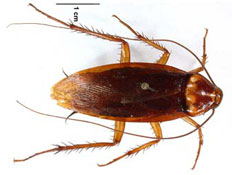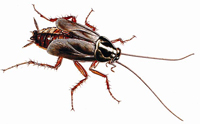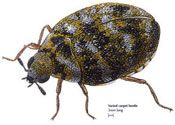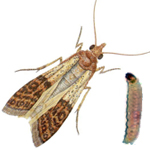Beetles, Coackroaches & Other Insects

American Cockroach: The largest of the common species, growing to a length of 1 1/2″ or more. Reddish-brown with a yellow border on the back of the pronotum. The wings of the male extend beyond the tip of the abdomen, while the female’s wings are about the same length as the abdomen. Found in the dark, moist areas such as around bathtubs, clothes hampers, sewers and basement corners.

German Cockroach: Their color varies from light brown to tan, except for 2 dark streaks on the shield-like segment behind the head. They prefer infesting the kitchen and bathroom, but will live anywhere that is heated, has food, water and harborage. They are active at night.
The most common roach in United States homes. Breeds throughout the year. Favors humid atmosphere and an average temperature 70°.
For prompt control of these damaging pests call our experts at
(781) 599-4317.

Oriental Cockroach: The Oriental cockroach or waterbug (Blatta orientalis) is a large species of cockroach, measuring about 1 inch in length at maturity. It is dark brown to black in color and has a glossy body.

Carpet Beetle: Most common in northern states. This beetle infest carpets and feeds on the fabric. It also feeds on animal products that are left undisturbed such as wool, leather, furs, etc.
These beetles are small and oval in shape. They’re grayish black in color with a varied pattern of white and orange scales on the back. An orange-red band of scales runs down the middle of the back.

Powder Post Beetles: Second only to termites in destroying wood, Powder Post Beetles leave small, round holes in wooden articles along with a residue of fine, powder-like dust.
These beetles range from 1/12″ to 1/3″ in length and from reddish-brown to black in color. The basal segment of the abdomen is as long as the second and third combined. The body is flattened and the head is visible from above.

Sawtoothed Grain Beetle: The sawtoothed grain beetle and its look-alike relative, the merchant grain beetle, are slender, flattened, reddish-brown beetles that measure about 1/8 inch in length. They exhibit saw-like teeth along the edge of the prothorax (shoulder area). These beetles feed on a wide variety of foods. While some come in from outdoors, most come in on purchased food, particularly dry pet food. These beetles can enter a home in large and disturbing numbers to feed on food, such as bird seed or pet food, which mice or other rodents have stored in wall voids.

Centipedes: A flat, wormlike body. 1″ or more in length with one pair of long legs for almost each body segment. The house centipede is grayish-yellow with three dark stripes running the length of the body. It has 15 pairs of legs with hind legs more than twice its body length.
Found throughout the country. House centipedes live in damp areas such as cellars, closets, bathrooms. Outdoors they can be found in damp locations under leaves and stones.

Millipedes: Unlike centidpedes, millipedes have round bodies, not flattened. Plus, they have two pairs of legs for almost each body segment. They’re brownish in color and are usually between 1/2″ and 1 1/2″ long. They coil up when resting.
Normally found outdoors in damp places such as under leaves and in mulch. At times they swarm into building basements and first floor rooms.

Earwigs: Earwigs are most readily recognized by the forceps at the end of the abdomen. Species range from 1/2″ to 1″ in length, and from light reddish-brown to jet black in color. Some species are marked with stripe or band on the boyd and legs.
Earwigs are active at night and hide in cracks or underneath objects during the day. Most species scavenge on dead animal and plant material. Eggs are laid in underground burrows.

Indian Meal Moth: The outer two thirds of the forewings are bronze or copper in color while the upper third are yellowish-gray, with a dark band at the interface between the two. The wingspan is 16-20 mm.
Up to 300 eggs are laid directly onto the food surface. These are smaller than 0.5 mm and not sticky. The larvae (Waxworms) are off-white, with a brown head and approximately 12 mm long when mature.
They are commonly called “flour moths” or “pantry moths.”

Sowbugs & Pillbugs: Oval bodies, convex above and flat or hollow underneath. Never over 3/4″ long. Both have seven pairs of legs. The sowbug has two tail-like appendages that prevent it from rolling up in a ball. The pillbug, however, lacks these appendages and rolls itself into a tight ball.
They prefer moist locations and can be found under vegetable debris or any object on damp ground. Frequently invade damp basements, crawl spaces and may infest potted plants.
They are commonly called “flour moths” or “pantry moths.”

Spiders: Eight legs with no wings or antennae. Their bodies have only two sections-a fused head and thorax, and an abdomen. All spiders have a pair of jaw-like structures with a hollow, claw-like fang at the end. Depending on the species spiders can be found in both damp and warm dry parts of buildings. Most species hide in cracks, darkened areas or in shelter they make from silk.
They prefer moist locations and can be found under vegetable debris or any object on damp ground. Frequently invade damp basements, crawl spaces and may infest potted plants.
They are commonly called “flour moths” or “pantry moths.”
